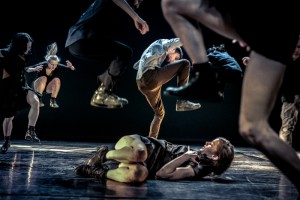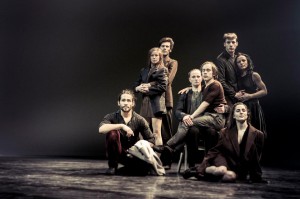By Rachel Straus
In the 1980s, punk rock, Ridley Scott’s “Blade Runner,” and Mike Tyson’s boxing championships made the ear-splitting, the nocturnal, and the hard-hitting de rigueur. Contemporary dance followed, becoming faster, more brazen and muscular. When the Belgian Wim Vandekeybus arrived on the scene with his first work, “What the Body Does Not Remember” (1987), New York Times dance critic Anna Kisselgoff began her review with these six slamming words: “Tough, brutal, playful, ironic and terrific.” So it was with great anticipation that I attended, at Madrid’s Teatros de Canal on November 23, the reprisal of the dance, which is making a two-year world tour in celebration of the work’s 25th anniversary.
The first scene of “What the Body Does Not Remember” did not disappoint. Maria Kolegova and Livia Balážová, of Vandekeybus’s company Ultima Vez, treated the floor like it was a wrestler, bouncing off and being mysteriously pinned down by it. Meanwhile Zebastián Méndez Marín’s thudding and scraping sounds on a miked table produced a vision of an invisible combatant seeking to destroy the flailing dancers with what sounded like a sledge hammer and a whip. Francis Gahide’s lighting furthered the sense of gladiatorial imprisonment: horizontal streaks of light produced the illusion of a series of bars that the dancers appeared to be caught in. This physical and sonic intensity could not, and did not, last for the 90-minute duration of the work.
What ensued, instead, was a series of theater games, which were a letdown. White bricks were thrown and expertly caught by the eight dancers. In another scene, dancers wrapped in brightly colored towels walked across the diagonal and then were stripped of this covering by another passerby. With little on except underpants, the dancers’ near nudity created titters among the audience seated in the sold-out house. Later, in a series of tableaus, or proto group-portrait selfies, Vanderkeybus turned the ensemble into perfectly posed families, each person more confident than the other. The center of the work involved three men continual frisking three women, who were standing in a wide leg-and-arm “X” position. The experience of watching this wasn’t frightening as much as confounding. As the frisking was repeated, two female performers pretended to begin to enjoy the act. Their occasional erotic overtures to their aggressors, however, were hardly convincing. It’s difficult to portray the Stockholm Syndrome without providing motive.
All of the scenes related above demonstrate aspects of human aggression. But the treatment of this subject in its various iterations felt jejune rather than profound. They possessed in aggregate the impact of the mundane, such as the different pieces of clothing that the performers put on and cast off. In contrast, the expertly shot, minute-long promotional video of the dance is riveting (https://www.youtube.com/watch?v=18pe0-8fjpY).
Why did the live performance not deliver? Part of the reason could stem from performance fatigue. These eight dancers have been reenacting “What the Body Does Not Remember” for two years. In the work there are no dance steps to hide behind. The performers must interact with each other like it is the first time. To convincingly do so, night-after-night, they need to be brilliant actors. They are brilliant physical artists, and that is saying a lot, but for the purposes of this work, it is not enough. Some works can’t be performed too much. If they do, they lose their punch.
I haven’t mentioned the music yet because I’m trying to erase it. According to the plentiful literature produced by Vandekeybus about “What the Body Does Not Remember,” which includes this resource pack (http://ultimaveztour.co.uk/UltimaVez-ResourcePack.pdf), composers Thierry De Mey and Peter Vermeersch responded to what they saw in the dancers’ rehearsal process. What they came up with sounds like a cross between an action movie sound track, an amateur garage band improvisation, and the music of Theodor Adorno.


